If you've ever recommended a product online, even if it was just an Instagram story, you’ve already dabbled in influencer marketing on a small scale.
Now imagine earning money every time someone clicks your link and buys something you genuinely like. That’s exactly what the Amazon Influencer Program lets you do.
It’s not just for mega-celebrities or viral TikTokers. You can start earning as an Amazon influencer even with a small but engaged audience if you approach it strategically.
In this guide, you’ll learn:
- How the Amazon Influencer Program works
- What you need to apply and get approved
- The core skills you’ll need to succeed long-term
- And how to grow your influence into a real revenue stream
Let’s break it down step by step.
What is the Amazon Influencer Program?
The Amazon Influencer Program is a referral-based affiliate system designed for creators who share product recommendations through social media, video content, blogs, or livestreams. Once you're accepted, you get your own Amazon storefront, which is a custom page where you can curate and promote your favorite products.
When someone buys through your storefront or one of your tracked links, you earn a commission between 1 and 20 percent, paid directly by Amazon.
It’s a simple model: You recommend. They buy. You get paid.
Amazon influencers vs. affiliate marketing
If you're familiar with Amazon’s Associates Program (their traditional affiliate system), you might be wondering, what’s the difference?
Here’s how they compare:
| Feature | Amazon Influencer Program | Amazon Associates Program |
|---|---|---|
| Primary Platform | Social media (Instagram, TikTok, YouTube, Facebook) | Websites, blogs, email newsletters |
| Storefront Availability | Yes, personalized Amazon storefront | No dedicated storefront; links embedded in own platforms |
| Content Integration | Shoppable videos, photos, live streams on Amazon | Affiliate links within external content |
| Link Sharing Flexibility | Online and offline (e.g., PDFs, print materials) | Primarily online; restrictions on offline sharing |
| Global Monetization | Limited; separate storefronts per marketplace | Broad; supports international traffic via OneLink |
| Ideal For | Influencers with active social media followings | Content creators with established websites or blogs |
In short: the Influencer Program is more creator-focused. It's built for people posting on TikTok, Instagram, YouTube, or livestreaming via platforms like Amazon Live. It's less about pasting links and more about building a shoppable brand.
Benefits and opportunities for Amazon influencers
There’s more upside here than just commissions. As an Amazon influencer, you can:
- Create a curated storefront that reflects your personal brand
- Earn passive income every time someone shops from your links
- Join Amazon Live, where you can livestream product reviews and demos
- Get featured on product pages or within Amazon’s own promotional ecosystem
- Build trust with your audience through authentic recommendations
Plus, unlike one-off brand deals, your Amazon links work for you 24/7. A single viral post can generate commissions for weeks (even months) after it goes live.
Market trends and data
The global influencer marketing industry is projected to hit $32.55 billion in 2025, up from $24 billion in 2024. That’s a 35.6% year-over-year jump, driven by brands shifting more of their budgets toward creators who can connect directly with niche audiences.
And micro-influencers (10,000 to 100,000 followers) see up to 60% higher engagement rates than their larger counterparts. Why? Because their content feels more personal, more real, and followers trust them more.
Amazon isn’t sitting this out. The Influencer Program is the company’s play to stay ahead of the curve. Instead of relying solely on ads or search rankings, they’re empowering creators to promote products in authentic, relatable ways, then rewarding them for the sales they drive.
How much can you make from Amazon's Influencer Program?
As for how much you can get paid per sale, that varies by category. There are more than a dozen to choose from, with commission rates varying from as low as 1% to as high as 20%.
Here's a breakdown of the commission rates by category:
| Product Category | Commission Rate |
|---|---|
| Amazon Games | 20.00% |
| Luxury Beauty, Luxury Stores Beauty, Amazon Explore | 10.00% |
| Amazon Haul | 7.00% |
| Digital Music, Physical Music, Handmade, Digital Videos | 5.00% |
| Physical Books, Kitchen, Automotive | 4.50% |
| Amazon Devices (Fire Tablets, Kindle, Echo, Ring), Amazon Fashion (Private Label), Apparel, Watches, Jewelry, Luggage, Shoes, Handbags & Accessories | 4.00% |
| Toys, Furniture, Home, Home Improvement, Lawn & Garden, Pet Products, Headphones, Beauty, Musical Instruments, Business & Industrial Supplies, Outdoors, Tools, Sports, Baby Products, Amazon Coins | 3.00% |
| PC, PC Components, DVD & Blu-Ray | 2.50% |
| Televisions, Digital Video Games | 2.00% |
| Amazon Fresh, Physical Video Games & Consoles, Grocery, Health & Personal Care | 1.00% |
| Gift Cards, Wireless Service Plans, Alcoholic Beverages, Digital Kindle Subscriptions, Vehicles | 0.00% |
| (Leasing & Sales), Restaurant Food Delivery, Amazon Appstore, Prime Now, Amazon Pay Places All Other Categories | 4.00% |
Note: Commission rates are subject to change. Always refer to the Amazon Associates Central for the most up-to-date information.
How that translates to actual money in the bank varies wildly. Follower count, engagement rates, content quality, product categories, and the prices of the products you promote all play a role.
- One influencer with approximately 1,100 shoppable videos reported earning between $2,000–$4,000+ per month.
- Another mentioned on Reddit making around $1,000/month when uploading 300–500 engaging videos of items priced between $40–$200.
This influencer made an extra $1,100 from 940 product sales in ~6 months.
Pre-requisites and Influencer Program requirements
Making money as an Amazon influencer isn't the hard part. It's actually pretty easy once you're set up, since Amazon storefronts are already partially conversion-optimized and you've already built up your following. The hardest part is getting accepted into the program.
This is what it'll take:
Eligibility criteria for 2025
To qualify for the Amazon Influencer Program in 2025, applicants have to meet specific criteria related to their social media presence and content quality.
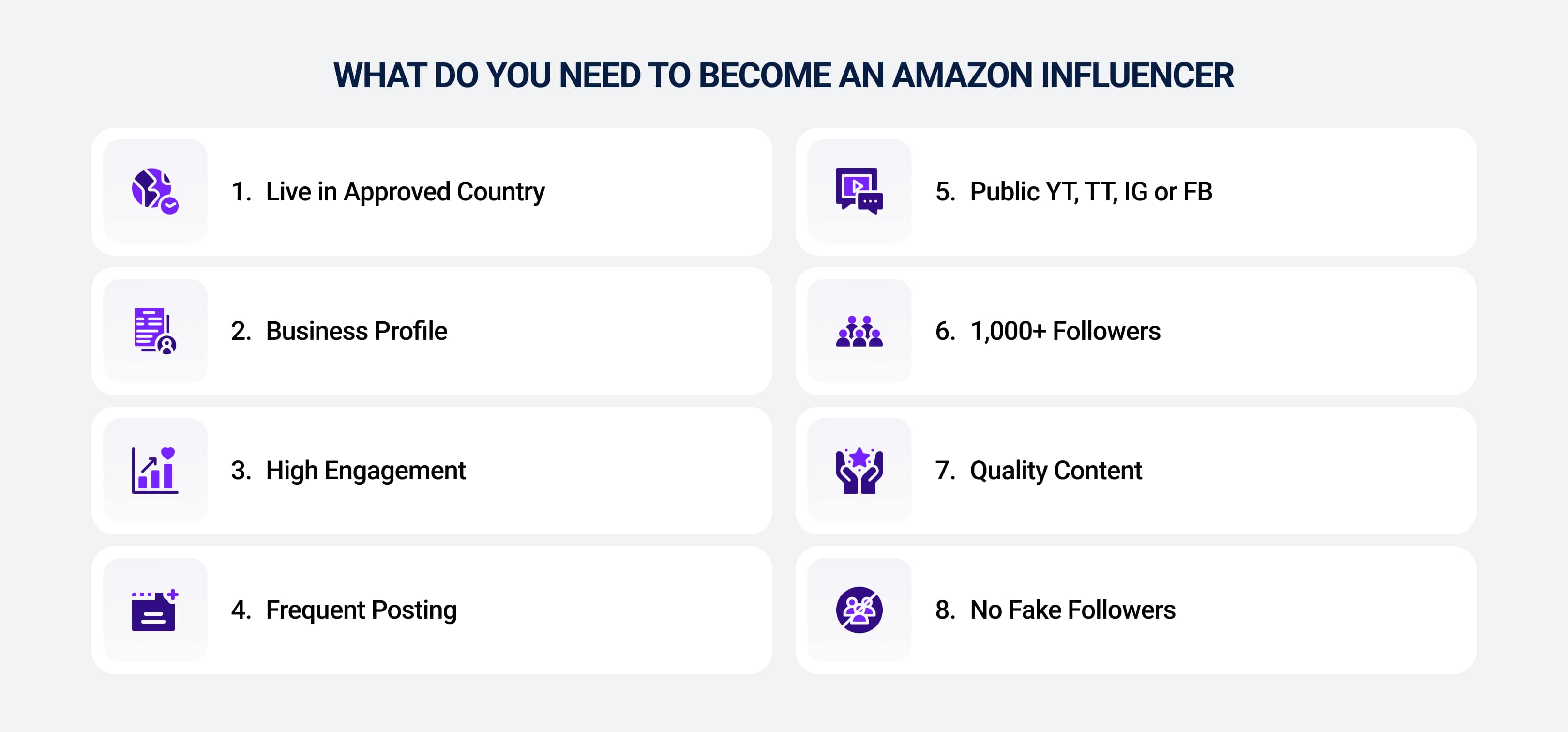
First and foremost, you must live or operate a business in either the US, Canada, France, Germany, Italy, Spain, UK, or India. And you need to have an active and public account on at least one of the following platforms:
- YouTube
- TikTok
- Instagram (Business account required)
- Facebook (Business page required)
Pro tip: We recommend linking the platform where you have the most substantial and engaged following.
Throughout the application process, Amazon evaluates several factors:
- Follower count: While Amazon discloses no official minimum, having at least 1,000 followers boosts your chances.
- Engagement rate: High engagement (likes, comments, shares) is crucial. A smaller, active audience is more valuable than a large, inactive one.
- Content quality: This is a big one. Consistent, original, and high-quality content that aligns with your niche is essential.
- Posting frequency: Regular posting indicates an active presence, which Amazon favors.
- Account authenticity: Accounts should have genuine followers and interactions.
GROW YOUR INSTAGRAM FOLLOWING VIA OUR CELEBRITY CAMPAIGNS
Leverage the power of the worlds A-list celebrities to grow your Instagram every month
VIEW CAMPAIGNSCore competencies and skills
Posting content as a creator or influencer is different from posting it for a commercial purpose. You don't want to be overly sales-y, but you do need to find ways to work products in your content — something you may or may not have done before.
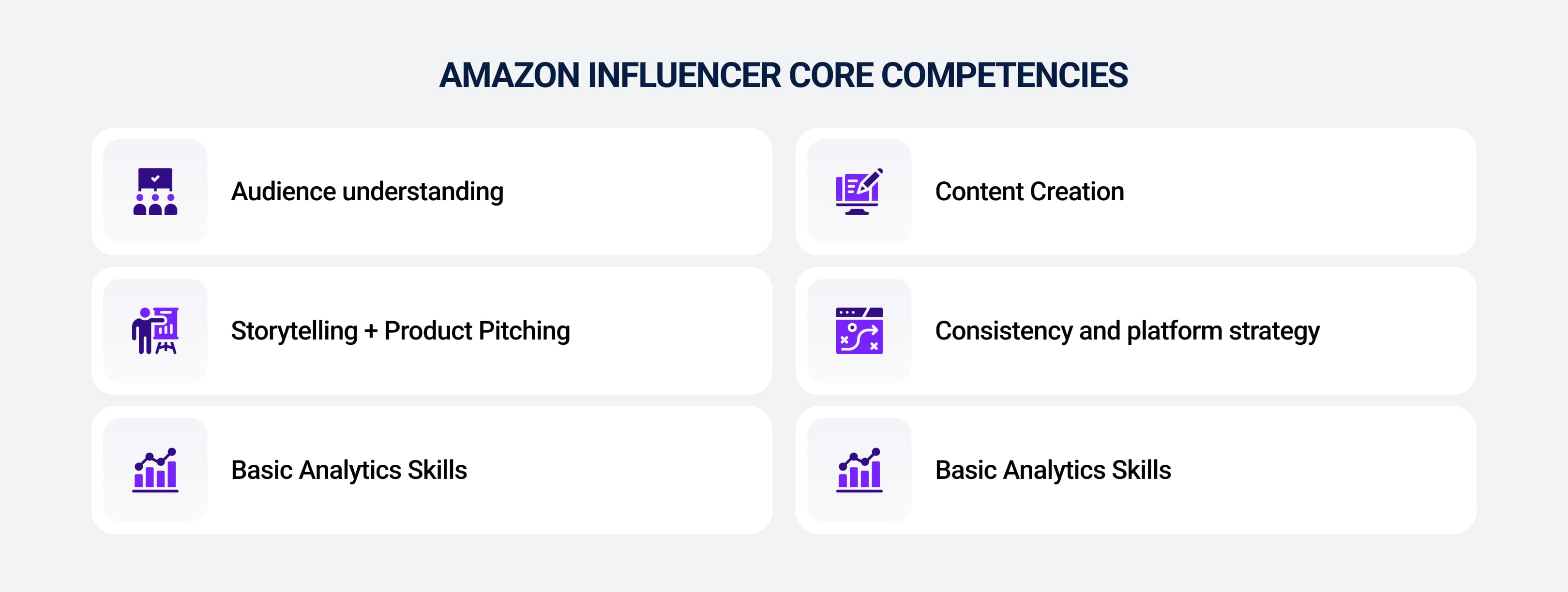
Here's what sets successful Amazon influencers apart:
Audience understanding
You should know exactly who you’re talking to. What do they buy? What do they care about? What problems are they trying to solve? Your product picks should feel handpicked for your audience.
Content creation
Strong influencers know how to grab attention and hold it. Whether you’re making short-form videos, livestreams, or product roundups, you need to be able to:
- Shoot clear, visually appealing content
- Write persuasive and concise captions
- Match your tone to your audience’s vibe
Storytelling + product pitching
People buy solutions, not products. You should be able to naturally explain why a product matters: how it works, why you love it, and who it’s best for. Great Amazon influencers make their recommendations feel like advice from a trusted friend.
Consistency and platform strategy
The algorithm rewards people who show up every day. You’ll need a posting schedule, content plan, and the discipline to stick to it. That includes knowing what kind of content performs best on your platform (e.g., recorded Amazon Live streams repurposed for Shorts, Reels, and TikTok).
Basic analytics skills
You don’t need to be a data scientist, but you do need to track what works. Understand which posts are driving clicks, where your traffic comes from, and which products convert best. That’s how you double down on what’s working and stop wasting energy on what’s not.
Branding and online presence essentials
Your personal brand is what separates you from every other creator linking to the same Amazon products. If you want to stand out and build long-term trust, you need to get intentional about your presence.
- Valuable content
- A well-defined niche
- Product-audience fit
- Optimized social media profiles
- Consistent branding, formatting, and messaging
- Strategic linking, placements, and product mentions
- An organized storefront with high-quality images and videos
That's the bare minimum when it comes to setting yourself up as a brand that sells products for Amazon sellers.
Amazon account setup and compliance
To maintain good standing in the Amazon Influencer Program, they've put forth some influencer content guidelines that prohibits the following when adding shoppable videos to your storefront:
- Plagiarized content
- Soliciting customer reviews
- External links, URLs, or CTAs
- Defamatory or derogatory language
- False medical claims or medical advice
- Content targeting or directed at children
- Spelling mistakes and grammatical errors
- Anything from alcohol manufacturers or distributors
- Disclosure of private information (e.g., phone numbers)
- Product tagging (except for products featured in your video)
- Copyright infringement (e.g., music or images you don't own)
- Use of Amazon’s intellectual property without written consent
In addition to these, your videos will need to abide by Amazon's Community Guidelines, as do all Amazon partners.
As for content that goes on your social media, you'll have to clearly disclose any affiliate relationships in your content, using appropriate hashtags like #ad or #sponsored. And you'll have to abide by their content guidelines.
8 steps to become an Amazon influencer
To succeed as an Amazon influencer, you need structure, clarity, and intent behind everything you do. These eight steps walk you through the process from prepping your digital presence to publishing content that actually converts.
Audit your online presence.
Before you even apply to the program, take a hard look at your existing channels. Ask yourself:
- Does my content speak to a specific audience?
- Would a brand know what I’m about in 5 seconds or less?
- Am I currently influencing anyone to take action — comments, DMs, shares, purchases?
If your profile looks like a personal diary with no clear theme, you’ll likely get rejected.
Look at your last 9 posts/stories. Can someone tell what kind of products you’d recommend based on just that? If not, refine before you apply.
Here's an example of a well-put-together Amazon influencer profile (@alliephunter):
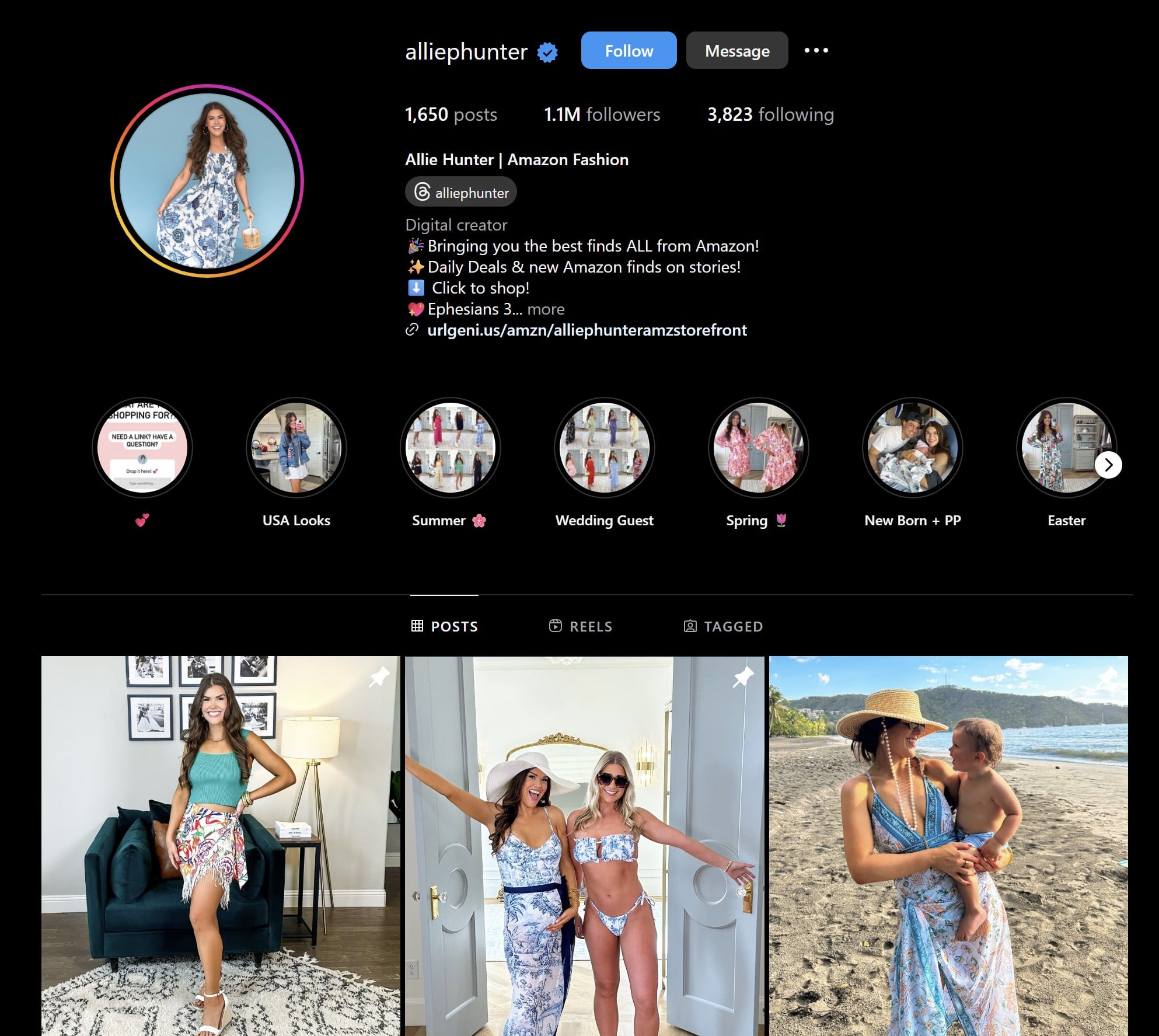
You know exactly what she’s selling and what kind of content she creates before you even click on one of her videos.
Pick a niche and a target audience.
If you’re already creating content, chances are you already have a niche. Start by revisiting your past posts, videos, and stories. Look for patterns:
- What themes come up again and again?
- What types of comments do people leave?
- Have you already recommended products, even casually?
For example, Teresa Laura Caruso (@teresalaucar) is into organization and interior design. She loves beige tones, and all of her content reflects that. Not one post misses (not even her profile picture).
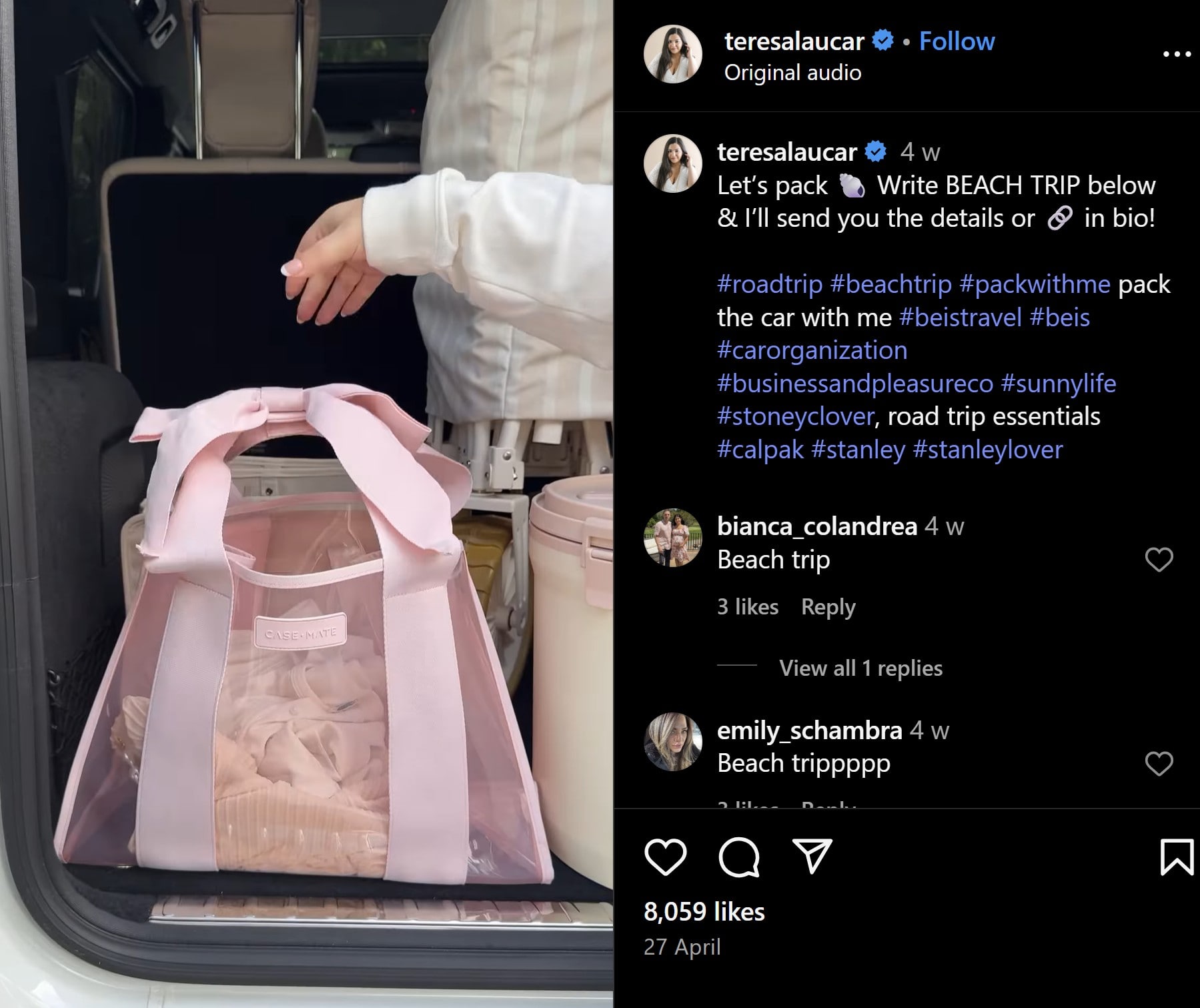
You can also switch up your niche over time. Brooke Hubbard (@hellomrshubbard) is having a baby soon, so her content now revolves around maternity-related products.
When she has her child, we’re willing to bet it’ll follow her as she discovers the best Amazon products for newborns and nursing mothers.
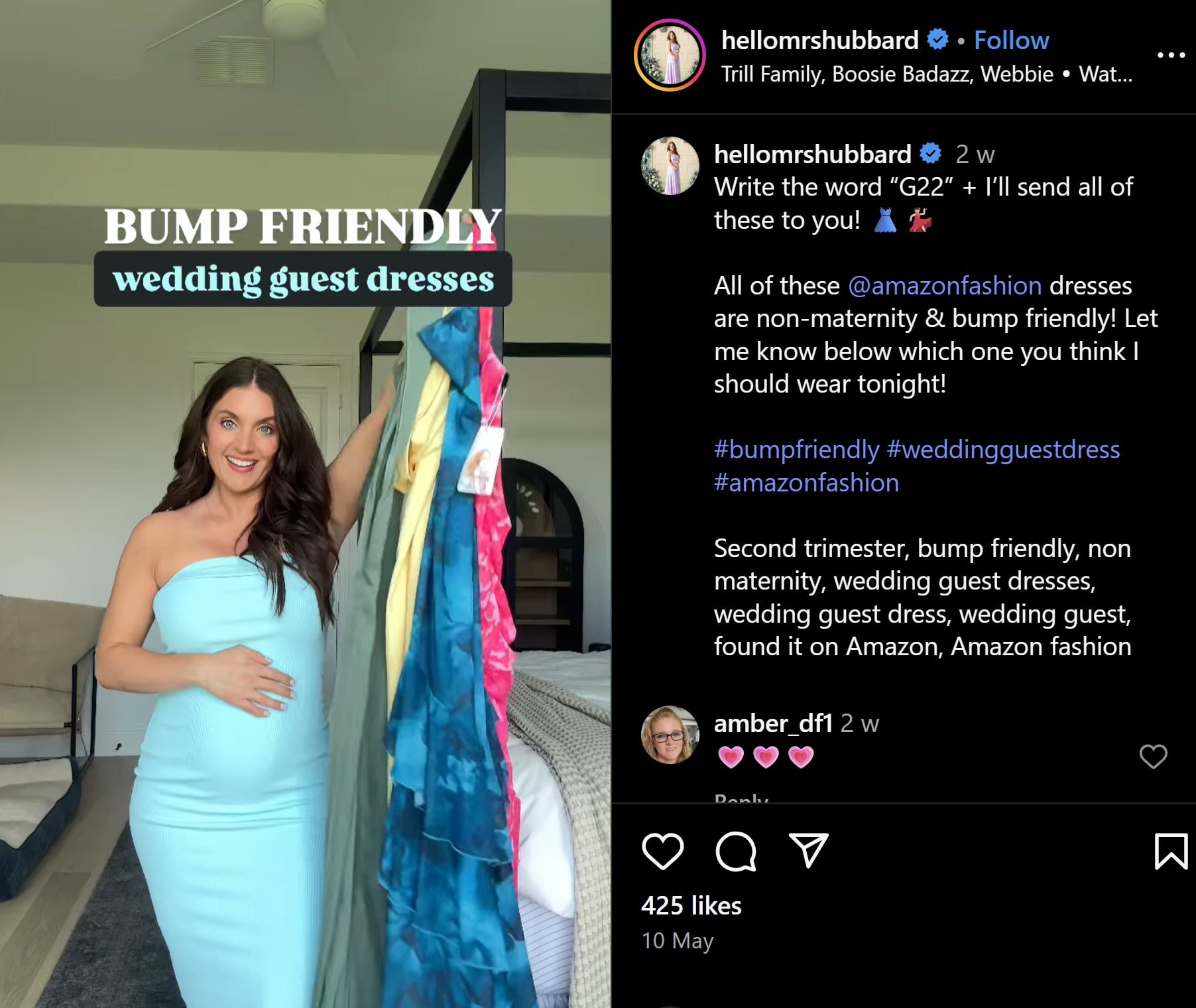
Develop a robust content strategy.
You need a repeatable, strategic approach to content that builds trust and drives clicks. A strong content strategy answers three questions:
What kind of content am I creating?
There are three content types that drive the Amazon influencer engine.
- Discovery content introduces your audience to a problem they didn’t know they had (e.g. “5 Things You Didn’t Know You Needed from Amazon”).
- Educational content shows how a product solves a problem (e.g. unboxings, tutorials, “how I use this in my day”).
- Conversion content builds urgency to buy now (e.g. “Amazon deals you can’t miss today,” gift guides, “I’ve bought this 3x” reviews).
Where am I posting it?
Lean into the platforms where your audience actually hangs out.
- TikTok and Reels = High discoverability, short attention span
- YouTube longform = Deeper dives, stronger trust
- Instagram Stories = Casual, frequent product plugs
- Amazon Live = Direct selling to high-intent shoppers
How often am I posting?
Consistency beats intensity. Plan a realistic cadence:
- 2–3 videos per week
- 1–2 Stories or Lives featuring your Amazon products
- Monthly themed content (e.g. “August Amazon Faves,” “Back to School Picks”)
Go through the Amazon Influencer application process.
The first thing you're going to do here is head to Amazon's official Influencer Program sign-up page. This is separate from the standard Amazon Associates Program — don’t get them confused.
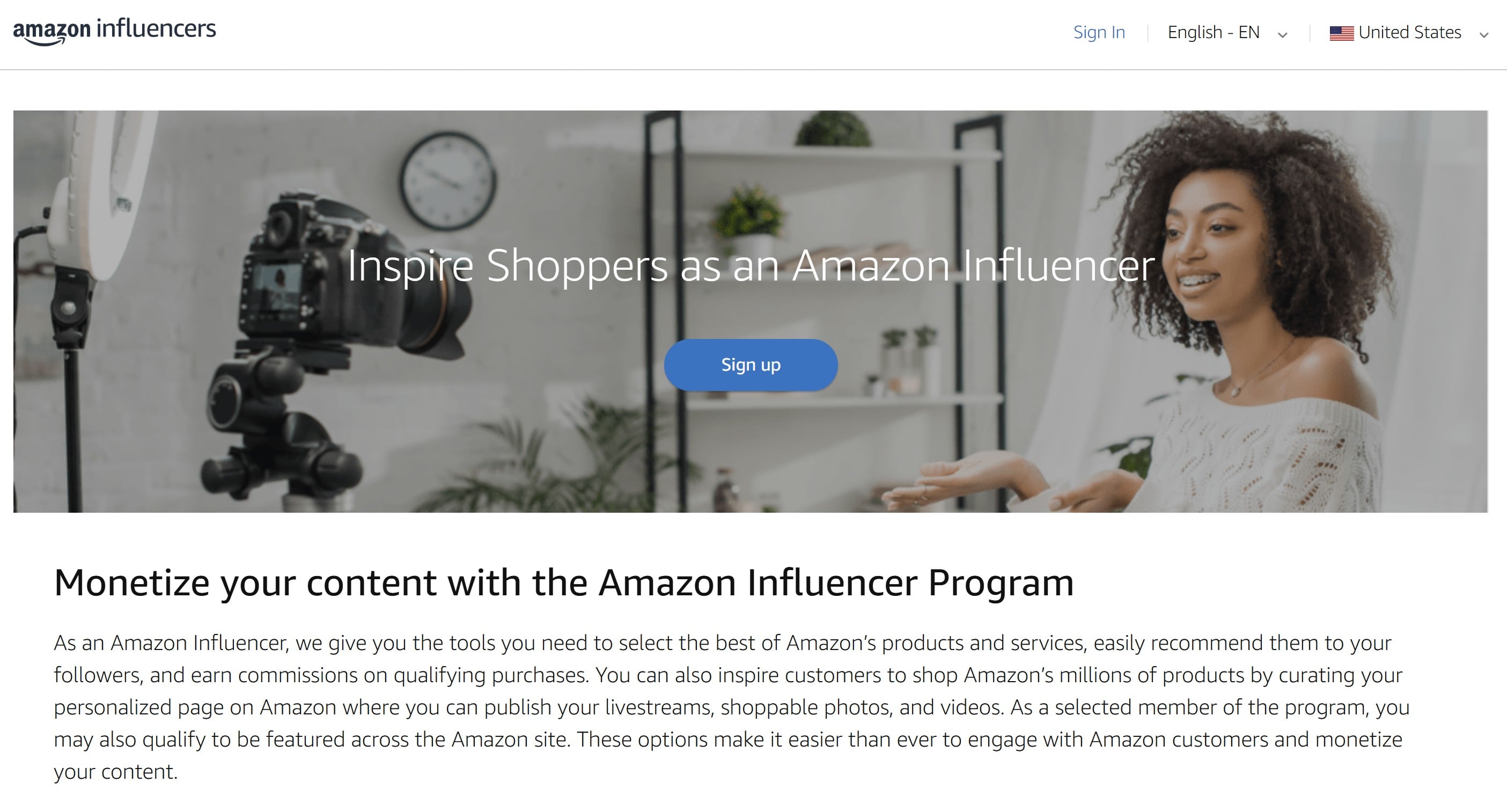
Then, pick either your Instagram, TikTok, YouTube, or Facebook account. You only need one to qualify, so we recommend using the one that has the most engagement, has the most followers, and is aesthetically superior.
When you click Sign Up, you'll have the option to either connect your existing Amazon account or create a new one.
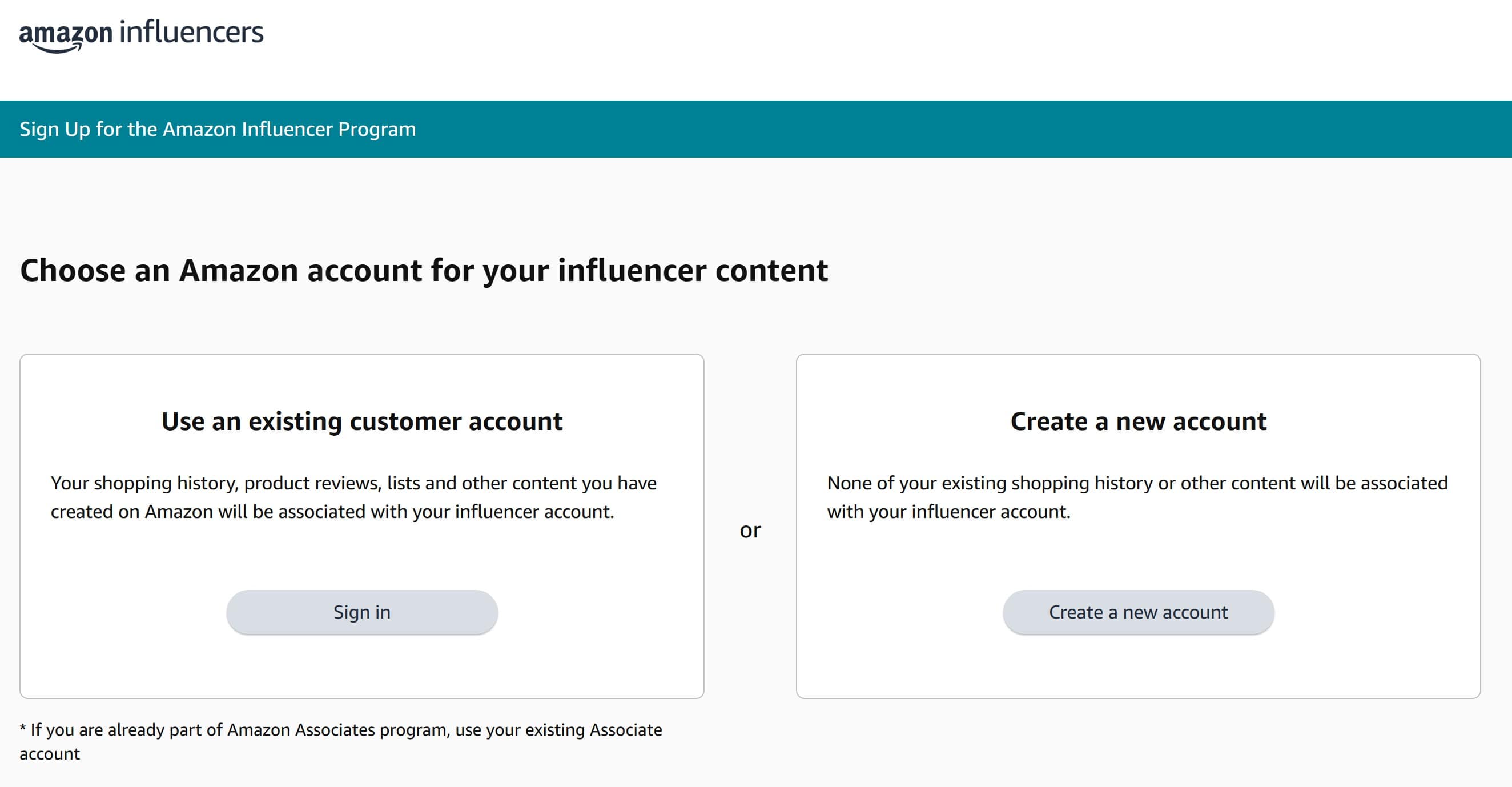
If you apply with YouTube or Facebook, approval happens right away. If you do so with IG or TikTok, the decision takes 3-5 days because there is a manual review aspect.
If you get denied, don’t panic. There's a chance you gave them the wrong account, so you can try with a different one. And if not, you can also tweak your profile to highlight product-related content, then try reapplying after making strategic changes.
Set up and optimize your Amazon storefront.
Your Amazon storefront is essentially your landing page. You'll direct your social media traffic here so they can see your curated product picks, buy something, and earn you a commission. It’s not fully customizable like your own website, but there are still a few things you can do to make it polished, on-brand, and conversion-friendly.
Your profile picture is first. Use the exact same one you use on Instagram, TikTok, or YouTube. When someone clicks from your IG bio or TikTok video and sees a familiar face, they immediately know they’re in the right place.
The bio section is a short, text-only section under your name. You can use it to quickly reinforce your niche (“Tech finds for content creators”), add a personal touch (“Dog mom. Budget traveler. Amazon deal hunter.”), and include a subtle CTA (“Shop my favorite finds below").

Idea lists are the clickable tiles that appear above your storefront feed, but below your bio section. You’ve probably seen them labeled things like “Fall Fashion Finds” or “Kitchen Gadgets I Actually Use.”
Pro tip: Use seasonal or trend-based names to catch attention and drive clicks (e.g., “Back to School on a Budget” or “TikTok Favorites Under $30”).

Within each idea list, you can add folders of products.
Each folder includes a list of different products you've selected.
The main product feed is where you can really showcase your content style. You can add:
- Photos (outfit flatlays, room setups, product in use)
- Videos (TikTok re-uploads, Amazon Live clips, short demos)
- Shoppable images with multiple product tags
- Individual product posts with written captions
Every piece of content here should link directly to one or more Amazon products.

Pro tip: Amazon prioritizes video content in search and on product pages. The more short videos you upload, the better your chances of getting placement beyond just your own storefront.
TonyTechBytes does a great job of incorporating video on his storefront, and all of it is incredibly simple since it's just repurposed from TikTok.
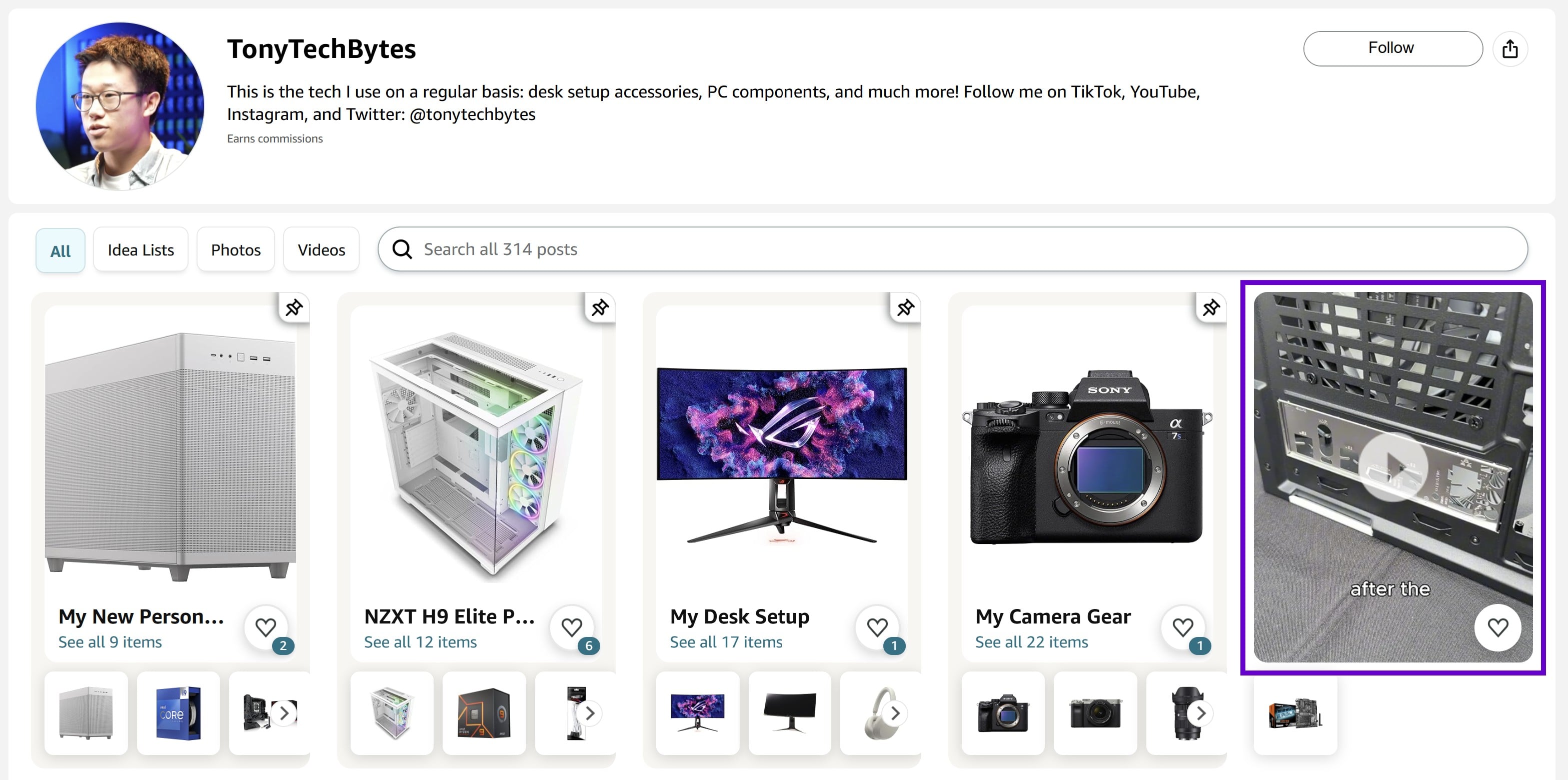
Get Shoppable Video approval.
Shoppable Videos are short clips you upload to your Amazon Influencer dashboard. But they unlock the biggest opportunity for passive sales in the entire program: your videos can start showing up directly on actual Amazon product pages, right alongside the “Buy Now” button and the seller's own product images.
This isn’t granted right after approval, though. To qualify for Shoppable Video placement, Amazon requires you to upload three product review videos.
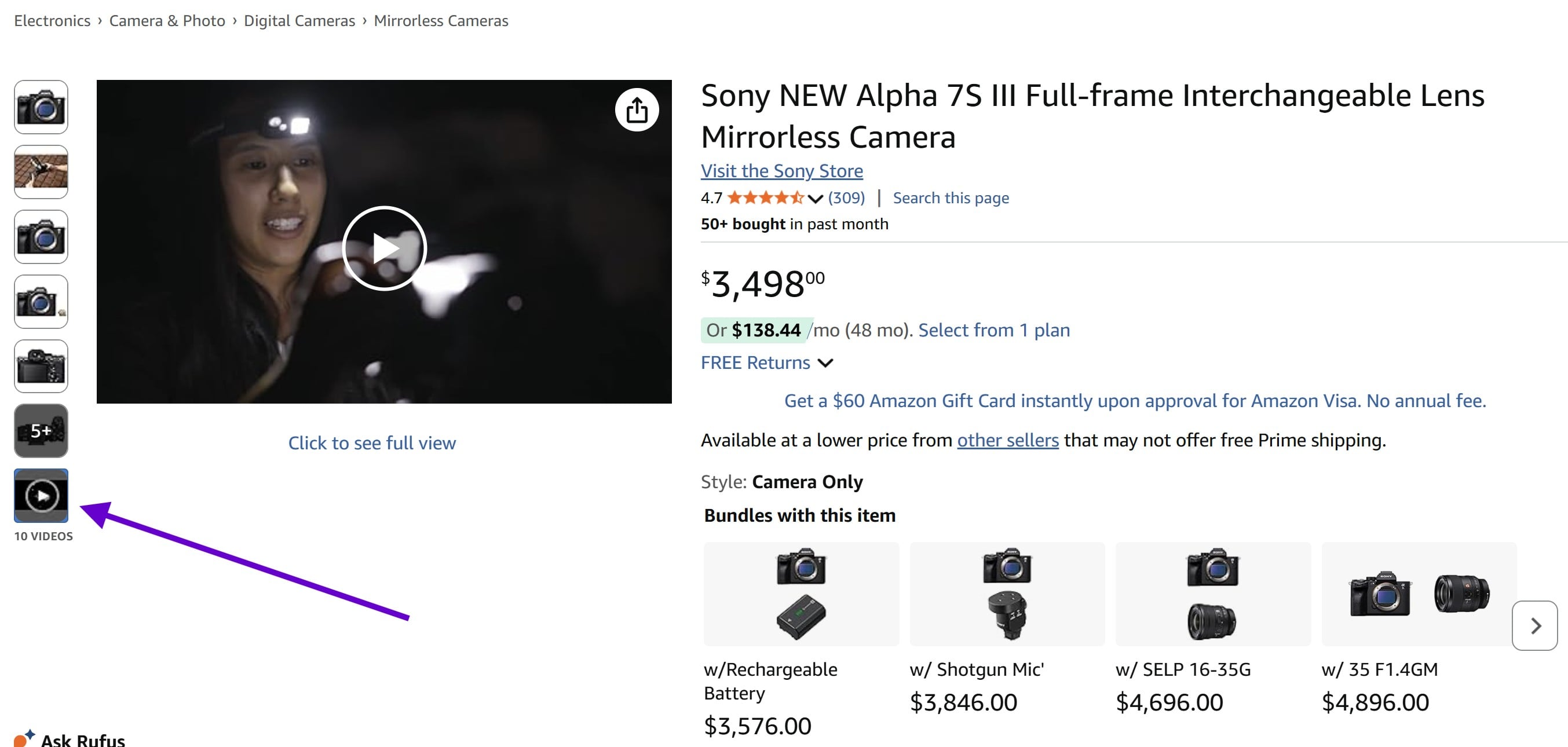
IMPORTANT: You only get three chances. If all three submissions are rejected, you lose access to Shoppable Video permanently.
The best strategy here is to pick easy wins. Choose products you actually use and can talk about confidently. Then, show the product, describe what it does, how you use it, and who it’s for. Show it in action in multiple use cases and give your honest thoughts.
Before you start to film, check out the videos on a few product listings in your niche for inspiration.
Launch and promote your Amazon storefront.
Your Amazon content should fit seamlessly into your existing feed. You don’t want it to scream “ad.”
How to do that:
- Be intentional with your calls to action (“Link in bio,” “Shop my storefront,” “Everything’s in my Amazon list”).
- Reference real use cases (“I’ve been using this for a month and it still blows my mind…”).
- Remind people your recommendations live in one central place (your storefront).
Here's an example of a well-executed launch video, from @georginalovestoread:
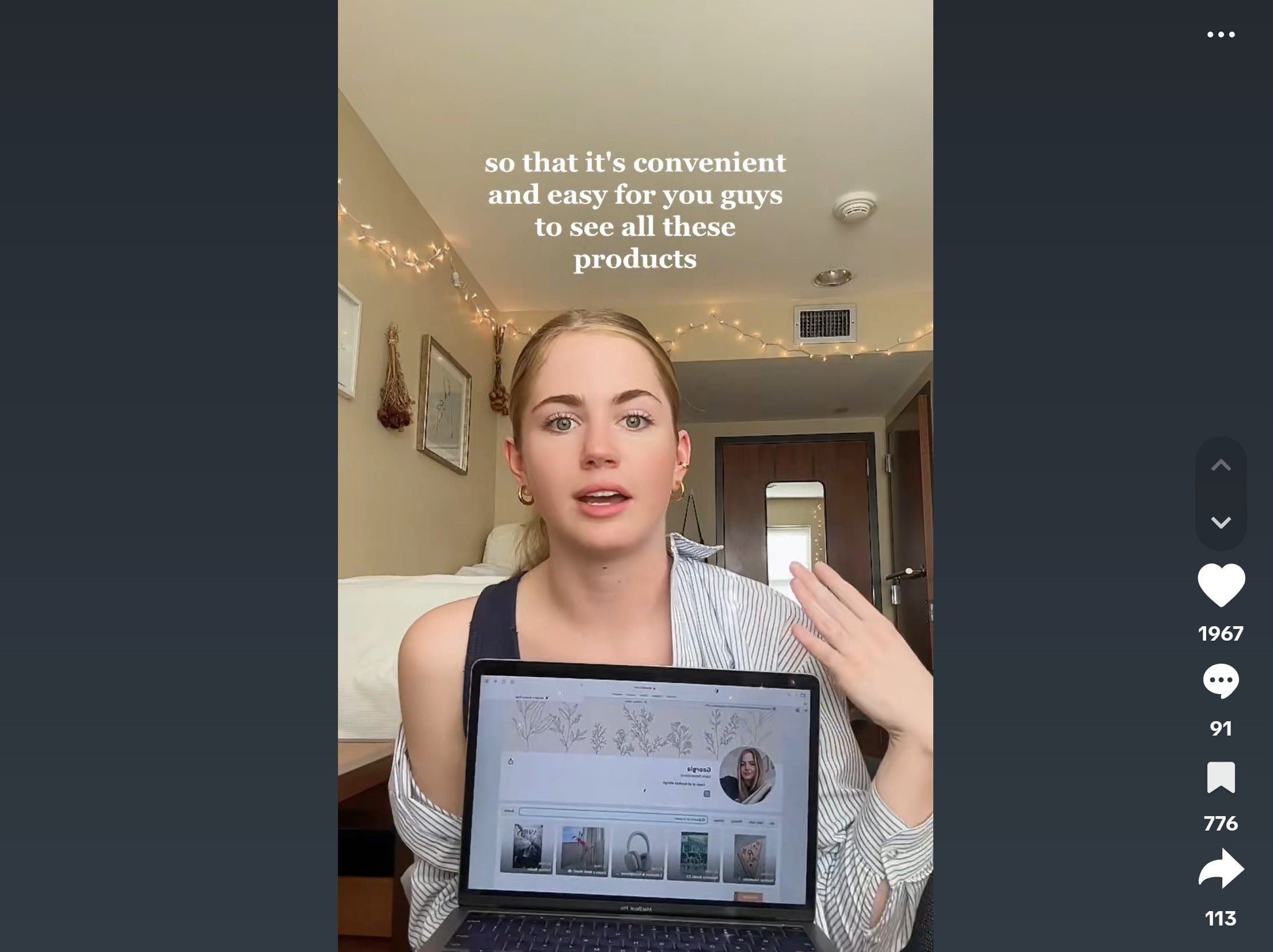
Monitor the results.
To grow as an Amazon influencer, you need to treat this like a business. And that means tracking what’s working, what’s not, and why.
Inside your Amazon Associates backend (yes, influencers use the same platform), you’ll find key metrics like:
- Clicks: How many people clicked your links
- Conversion rate: How many of those people actually bought something
- Total earnings: Commissions earned from your content
- Top-performing products: So you know what’s worth doubling down on
- Video views (if approved for shoppable content): Helps you see what performs on product pages
Watch for which content drives the most clicks by looking at platform, format (video vs. image), and call-to-action.
Also look into which products convert best and when your sales spike. You might think that viral gadget is a goldmine, but your audience might be loving the low-key home organizer more. Those things might change at different points in the day, week, or year.
And of course, adjust your content strategy based on these findings.
Amazon influencer tips and best practices
Now... the Amazon Influencer Program isn’t a “set it and forget it” play. To grow your income and your influence, you need to work smart and strategically.

Here are the four best practices we see all successful influencers follow:
Create authentic content.
People don’t want to feel sold to—they want to feel helped. Your recommendations should feel like real advice you’d give a friend, like you're talking just to them, not a sales pitch you’re forcing into the feed.
- Be honest: if there’s a downside to a product, say it.
- Show how you actually use the product in your life.
- Talk about why it’s useful, not just what it is.
Optimize your social media platforms.
You don’t need a massive audience—but your profiles should be tight, clear, and aligned with your niche.
- Pin product-related content at the top of your feed
- Add your Amazon storefront link to your bio (use a tool like Beacons or Linktree if you promote multiple links)
- Highlight Amazon content in Stories, Highlights, or featured playlists
- Post consistently so the algorithm and your audience know what to expect
The easier it is to find your Amazon content, the more sales you’ll generate.
Use SEO and algorithms to your advantage.
Amazon is its own search engine, and so is every social platform you post on (especially TikTok). To boost discoverability, use keywords in your video titles and captions (e.g. “best Amazon kitchen finds 2025”).
It's also a good idea to add relevant hashtags that match shopper intent (e.g. #AmazonMustHaves, #GadgetGoals, #TiktokMadeMeBuyIt). And align your content with search behavior (think: seasonal trends, holiday gift guides, or “back to school” roundups).
Monetize strategically.
Don’t just drop links and hope for clicks. Use smart monetization tactics:
- Build curated lists to increase basket size (“All My Amazon Kitchen Tools”).
- Create limited-time content for urgency (“Amazon deals you need to grab TODAY”).
- Cross-promote products that naturally go together.
- Run themed series to encourage return visits (e.g., “Sunday Amazon Finds” or “Monthly Must-Haves”).
And remember: your storefront is just like any other funnel. The better you guide people through it, the more you’ll earn.
Case studies and Amazon influencer success stories
Success with the Amazon Influencer Program doesn’t require millions of followers. Here are four real-world examples to show you what’s possible:
James Pelton: From daily affirmations to daily sales
James started out by posting daily affirmations on TikTok. As his following grew, he pivoted into product review videos and applied to the Amazon Influencer Program.
In his first full month, he earned $320. By month two, he was on track for $1,200+.
His key? Consistent posting and leveraging short-form video to build trust quickly.
GoTechGeek's strategic video content
On Reddit, a user named gotechgeek shared their experience after 1.5 years in the program. They reported earning $2,500–$3,000 per month, with income spiking during the holidays.
Here’s what worked for them:
- Creating high-quality, informative videos
- Using comparison-style content to drive purchase decisions
- Continuously adjusting their strategy as the platform evolved
Their biggest lesson? Treat your storefront like a content business, not just a side hustle.
YouTube creator: Shay's $15k/month journey
In a candid YouTube podcast, Shay shares her experience of earning $15,000 per month through the Amazon Influencer Program. She discusses strategies like focusing on high-commission product categories and creating engaging video content to drive sales.
Documented earnings series: "Started"
The "Started" YouTube playlist published by Casey Botticello chronicles the journey of an Amazon Influencer from initial setup to $2,249/month earnings. It offers a step-by-step guide, showcasing real-time progress, and lessons learned along the way.
Final thoughts
Becoming an Amazon influencer isn’t about going viral or gaming the algorithm—it’s about building a real, trust-based connection with your audience and turning that trust into smart, sustainable income.
The opportunity is massive, but the people who succeed treat it like a business:
- They pick a clear niche
- They show up with consistent, valuable content
- They optimize, track, and adapt
- And they earn by helping, not just selling
Whether you’re just starting out or looking to turn your content into a serious revenue stream, the Amazon Influencer Program gives you the tools to do it — if you’re willing to put in the work, that is...
Frequently Asked Questions
Is it hard to get accepted as an Amazon influencer?
It depends on your content and audience. You don’t need millions of followers, but Amazon looks for active, public social media accounts with niche-focused content and consistent engagement. If your profile clearly shows you’re already influencing purchase behavior, even on a small scale, you’ve got a solid shot.
Who pays Amazon influencers?
Amazon does. You earn a commission from Amazon’s affiliate program every time someone buys a product through your storefront or link. Payouts are made directly by Amazon, typically 60 days after the sale, based on the category-specific commission rates.

